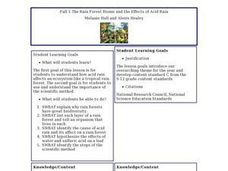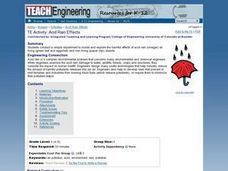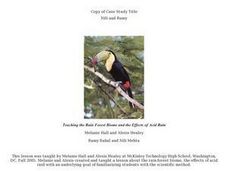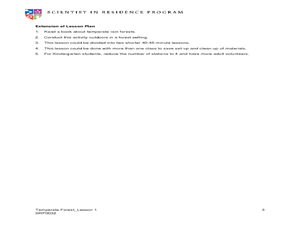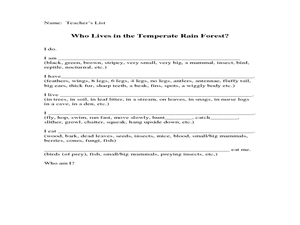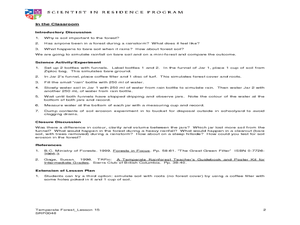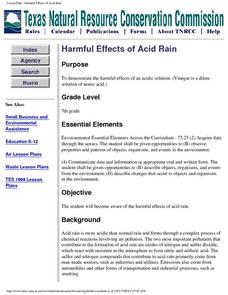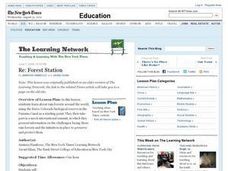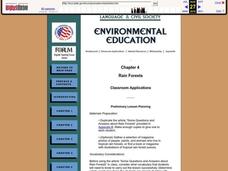Curated OER
Fall 1-The Rain Forest Biome and the Effects of Acid Rain - Biology Teaching Thesis
Students explain why rain forests have great biodiversity, and list each layer of a rain forest and tell an organism that lives in each. They identify the cause of acid rain and its affect on a rain forest. Students hypothesize the...
Curated OER
Forest Ecosystems
Forests are briefly defined and broken down into four different types in this PowerPoint. Facts and photos are provided for each type, including: deciduous, tropical rain, coastal, and coniferous forests. This is a wonderful presentation...
Curated OER
Acid Rain Effects
Get out the goggles and conduct a simple experiment to model and explore the harmful effects of acid rain (vinegar) on living (green leaf and eggshell) and non-living (paper clip) objects. Young chemists observe and describe the harmful...
Curated OER
The Earth's Rain Forests
Learners study the importance of the world's rain forests. In this rain forest instructional activity, students read about the role of the rain forests in the world's environment. Learners then write a formal letter to a member of...
Curated OER
Rain Forest Biome and the Effects of Acid Rain
Young scholars examine how acid rain affects the rain forest. They identify the causes of acid rain, determine how human behavior can affect the environment and discuss ways to prevent acid rain and acid rain damage to the rain forest.
Living Rainforest
Finding the Rainforests
From Brazil to Indonesia, young scientists investigate the geography and climate of the world's tropical rain forests with this collection of worksheets.
Curated OER
Math in Science-Rain Forest Math
In this rain forest worksheet, students use different basic math skills to calculate the percentage of Earth covered by rain forests today compared to fifty years ago. They study the effects of how cutting down trees contributes to water...
Curated OER
Rain Forests: A Disappearing Act?
Students examine and locate rainforests on maps, and research the patterns of their destruction. They develop a bar graph of rainfall and temperature data, write a journal entry, and research the people, animals, and plants/products of...
Curated OER
El Salvador: How Can My Breakfast Harm the Birds?
Sixth graders explore how their food choices can have an impact on the rain forests. They examine coffee farming and how their techniques can harm birds in the rain forest. Students design two farms with sustainability of bird habits in...
Curated OER
Exploring Forest Objects
Students explore the forest. In this ecosystems lesson, students rotate through sensory activity centers, brainstorm, and read about temperate forests.
Curated OER
Layers of the Forest
Learners explore rain forests. In this rain forest ecosystems lesson, students identify and describe the layers of the rain forest. Learners paint and decorate a large rain forest mural. Students write riddles about animals that...
Curated OER
Forest as a Filter
Learners experiment using soil and water. In this forest as a filter lesson, students identify the role of forest cover, vegetation, and foliage impacts erosion and evaporation. Learners conduct a simple experiment, form a hypothesis,...
Curated OER
Acid Rain
Young scholars investigate acid rain. In this environmental lesson, students participate in an experiment using litmus paper and various liquids and then test the acidity of the liquids. Young scholars identify reasons why acid is...
Curated OER
Harmful Effects of Acid Rain
Seventh graders are able to demonstrate the harmful effects of an acidic solution. They become aware of the harmful effects of acid rain. Students make predictions before they began the experiment. If vingegar contains acid, then how...
Curated OER
Acid Rain in our State
Learners conduct internet research on acid rain, a serious environmental problem. They examine the pH levels of rainwater for their state, collect data from their community and investigate the causes and solutions for acid rain.
Curated OER
Rain Forest Adventures
Students discover locations of the world's rain forests. Once they identify the animals, plants, products, and resources located in them, they construct they own rain forest terrariums. By comparing and contrasting the two types of...
Curated OER
Air Pollution: What's the Solution?
In this air pollution worksheet, students simulate acid rain falling on soil and determine the pH of the soil after spraying it with an acidic solution. They measure the pH of water sprayed with an acidic solution to represent the...
Curated OER
Tropical Rain Forests
Fourth graders read a story about the Rain Forest, participate in a class discussion, and complete the Canopy picture match with poems.
Curated OER
Re: Forest Station
Learners read an online article to explore rainforests of the world starting with the Barro Colorado reserve in the Panama Canal. They participate in a mock international summit about rainforest conservation issues.
Curated OER
What is a National Forest
Learners select and research a National Forest near their local community. They read and discuss the pamphlet "A Guide To Your National Forests," view photos of national forests, conduct Internet research, and complete the student...
Curated OER
Rain Forests
Students investigate rain forests. They view and discuss photos of rain forests, answer discussion questions, define key vocabulary words, and participate in a class discussion.
Curated OER
PRIMARY AND SECONDARY SUCCESSION IN AMERICA'S FORESTS
Young scholars examine forest organisms, features of some of the different types of forest, classify organisms based on the type of forest they come from, and explore how certain species are connected with other, particular species...
Curated OER
Forest Habitats
For this identification lesson, 3rd graders view photographs of different kinds of forests, learn where forests are located, and discuss seasonal changes in forests. Students read Look What I Did With a Leaf, collect leaves,...
Forest Foundation
Forest Watersheds
Where does the water we use come from? To understand the concept of a watershed, class members study the water cycle and then engage in an activity that simulates a watershed.
